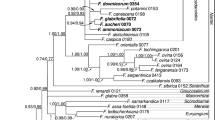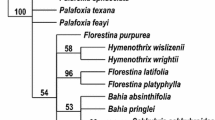Abstract
Cotoneaster Medik. (Rosaceae, Maloideae) is distributed in Europe, North Africa, and temperate areas of Asia except Japan. Members of the genus exhibit considerable morphological variation. The infrageneric classification is also obscured by polyploidy, hybridization, and apomixis. In this study, phylogenetic analyses were conducted to test infrageneric classifications of this genus using DNA sequence data from the nuclear ITS (nrITS) region and three chloroplast intergenic spacer regions. Maximum parsimony and Bayesian inference analyses of both datasets agreed with the two sections/subgenera of Koehne’s classification system, and suggested that four subsections (Microphylli, Chaenopetalum, Adpressi, and Cotoneaster) and the series of Koehne’s classification system were non-monophyletic. The incongruence length difference test indicated that the nrITS and cpDNA datasets were significantly incongruent (P = 0.001), and the placement of 14 species was discordant in phylogenetic trees derived from the two datasets. Within Cotoneaster, hybridization was indicated to be an important factor contributing to the incongruence between the nrITS and cpDNA data. By mapping nine morphological characters onto the combined nrITS–cpDNA phylogenetic tree, we inferred that a deciduous habit, glabrous fruit, white anthers, erect and light pink petals, and white filaments are plesiomorphic character states in Cotoneaster.



Similar content being viewed by others
References
Abbott RJ, Lowe AJ (2004) Origins, establishment and evolution of new polyploid species: Senecio cambrensis and S. eboracensis in the British Isles. Biol J Linn Soc 82:467–474
Ainouche ML, Baumel A, Salmon A, Yannic G (2004) Hybridization, polyploidy and speciation in Spartina (Poaceae). New Phytol 161:165–172
Alice LA, Campbell CS (1999) Phylogeny of Rubus (Rosaceae) based on nuclear ribosomal DNA internal transcribed spacer region sequences. Am J Bot 86:81–97
Álvarez I, Wendel JF (2003) Ribosomal ITS sequences and plant phylogenetic inference. Mol Phylogenet Evol 29(3):417–434
Arnold ML (1997) Natural hybridization and evolution. Oxford University Press, New York
Arnold ML (2006) Evolution through genetic exchange. Oxford University Press, New York
Bao Y, Wendel JF, Ge S (2010) Multiple patterns of rDNA evolution following polyploidy in Oryza. Mol Phylogenet Evol 55(1):136–142
Bartish IV, Hylmo B, Nybom H (2001) RAPD analysis of interspecific relationships in presumably apomictic Cotoneaster species. Euphytica 120:273–280
Bortiri E, Oh SH, Jiang JG, Baggett S, Granger A, Weeks C, Buckingham M, Potter D, Parfitt DE (2001) Phylogeny and systematics of Prunus (Rosaceae) as determined by sequence analysis of ITS and the chloroplast trnL-trnF Spacer DNA. Syst Bot 26(4):797–807
Campbell CS, Baldwin BG, Donoghue MJ, Wojciechowski MF (1995) Phylogenetic relationships in Maloideae (Rosaceae): Evidence from sequences of the internal transcribed spacers of nuclear ribosomal DNA and its congruence with morphology. Am J Bot 82:903–918
Campbell CS, Evans RC, Morgan DR, Dickinson TA, Arsenault MP (2007) Phylogeny of subtribe Pyrinae (formerly the Maloideae, Rosaceae): limited resolution of a complex evolutionary history. Plant Syst Evol 266:119–145
Chang CS, Jeon JI (2003) Leaf flavonoids in Cotoneaster wilsonii (Rosaceae) from the island Ulleung-do, Korea. Biochem Syst Ecol 31(2):171–179
Clausen J, Keck DD, Hiesey WH (1945) Experimental studies on the nature of species. II. Plant evolution through amphidiploidy and autopolyploidy with examples from Madiinae. Carnegie Institution Washington, Publication No. 564, Washington, D.C
Comai L (2005) The advantages and disadvantages of being polyploid. Nat Rev Genet 6:836–846
Comes HP, Abbott RJ (2001) Molecular phylogeography, reticulation, and lineage sorting in Mediterranean Senecio sect. Senecio (Asteraceae). Evolution 55:1943–1962
Dickoré WB, Kasperek G (2010) Species of Cotoneaster (Rosaceae, Maloideae) indigenous to, naturalising or commonly cultivated in Central Europe. Willdenowia 40(1):13–45
Doyle JJ, Doyle JL (1987) A rapid procedure for DNA purification from small quantities of fresh leaf tissue. Phytochem Bull 19:11–15
Drábková ZL, Vlček C (2010) Molecular phylogeny of the genus Luzula DC. (Juncaceae, Monocotyledones) based on plastome and nuclear ribosomal regions: a case of incongruence, incomplete lineage sorting and hybridisation. Mol Phylogenet Evol 57(2):536–551
Edwards C, Soltis DE, Soltis PS (2006) Molecular phylogeny of Conradina and other shrub mints (Lamiaceae) from the southeastern USA: evidence for hybridization in Pleistocene refugia? Syst Bot 31:193–207
Eriksson T, Donoghue MJ, Hibbs MS (1998) Phylogenetic analysis of Potentilla using DNA sequences of nuclear ribosomal internal transcribed spacers (ITS), and implications for the classification of Rosoideae (Rosaceae). Plant Syst Evol 211:155–179
Espinoza NR, Noor MAF (2002) Population genetics of a polyploid: is there hybridization between lineages of Hyla versicolor? J Hered 93:81–85
Farris JS, Källersjö M, Kluge AG, Bult C (1994) Testing significance of incongruence. Cladistics 10:315–319
Feliner GN, Rosselló JA (2007) Better the devil you know? Guidelines for insightful utilization of nrDNA ITS in species-level evolutionary studies in plants. Mol Phylogenet Evol 44(2):911–919
Flinck KE, Hylmö B (1966) A list of series and species in the genus Cotoneaster. Bot Notiser 119:445
Fryer J, Hylmö B (2009) Cotoneasters: a comprehensive guide to shrubs for flowers, fruit, and foliage. Timber Press, Portland and London
Gobert V, Moja S, Taberlet P, Wink M (2006) Heterogeneity of three molecular data partition phylogenies of mints related to M. X piperita (Mentha; Lamiaceae). Plant Biol 8:470–485
Goldman DH, Jansen RK, Berg CVD, Leitch IJ, Fay MF, Chase MW (2004) Molecular and cytological examination of Calopogon (Orchidaceae, Epidendroideae): circumscription, phylogeny, polyploidy, and possible hybrid speciation. Am J Bot 91:707–723
Grant V (1981) Plant speciation, 2nd edn. Columbia University Press, New York
Hamilton MB (1999) Four primer pairs for the amplification of chloroplast intergenic regions with intraspecific variation. Mol Ecol 8:513–525
Huelsenbeck JP, Ronquist F (2001) MrBayes: Bayesian inference of phylogeny. Bioinformatics 17:754–755
Kim ST, Donoghue MJ (2008) Incongruence between cpDNA and nrITS trees indicates extensive hybridization within Eupersicaria (Polygonaceae). Am J Bot 95(9):1122–1135
Koehne E (1893) Deutsch. Dendrol. 224
Li QY, Guo W, Liao WB, Macklin JA, Li JH (2012) Generic limits of Pyrinae: insights from nuclear ribosomal DNA sequences. Bot Stud 53(1):151–164
Lo EYY, Donoghue MJ (2012) Expanded phylogenetic and dating analyses of the apples and their relatives. Mol Phylogenet Evol 63:230–243
Lo EYY, Stefanović S, Dickinson TA (2007) Molecular reappraisal of relationships between Crataegus and Mespilus (Rosaceae, Pyreae)—two genera or one? Syst Bot 32:596–616
Mooring JS (2001) Barriers to interbreeding in the Eriophyllum lanatum (Asteraceae, Helenieae) species complex. Am J Bot 88:285–312
Norup MV, Dransfield J, Chase MW, Barfod AS, Fernando ES, Baker WJ (2006) Homoplasious character combinations and generic delimitation: a case study from the Indo-Pacific arecoid palms (Arecaceae: Araceae). Am J Bot 93:1065–1080
Paun O, Fay MF, Soltis DE, Chase MW (2007) Genetic and epigenetic alterations after hybridization and genome doubling. Taxon 56:649–656
Pelser PB, Kennedy AH, Tepe EJ, Shidler JB, Nordenstam B, Kadereit JW, Watson LE (2010) Patterns and causes of incongruence between plastid and nuclear Senecioneae (Asteraceae) phylogenies. Am J Bot 97:856–873
Petersen G, Seberg O (1997) Phylogenetic analysis of the Triticeae (Poaceae) based on rpoA sequence data. Mol Phylogenet Evol 7:217–230
Phipps JB, Kenneth RR, Paul GS, Joseph RR (1990) A checklist of the subfamily Maloideae (Rosaceae). Botany 68(10):2209–2269
Posada D, Crandall KA (1998) Modeltest: testing the model of DNA substitution. Bioinformatics 14:817–818
Potter D, Luby JJ, Harrison RE (2000) Phylogenetic relationships among species of Fragaria (Rosaceae) inferred from non-coding nuclear and chloroplast DNA sequences. Syst Bot 25:337–348
Potter D, Eriksson T, Evans RC, Oh S, Smedmark JEE, Morgan DR, Kerr M, Robertson KR, Arsenault M, Dickinson TA, Campbell CS (2007) Phylogeny and classification of Rosaceae. Plant Syst Evol 266:5–43
Rieseberg LH, Willis JH (2007) Plant speciation. Science 317:910–914
Robertson KR, Phipps JB, Rohrer JR, Smith PG (1991) A synopsis of genera of the Maloideae (Rosaceae). Syst Bot 16:376–394
Ronquist F, Huelsenbeck JP (2003) MrBayes 3: Bayesian phylogenetic inference under mixed models. Bioinformatics 19:1572–1574
Rydin C, Kallersjö M, Friis EM (2002) Seed plant relationships and systematic position of Gnetales based on nuclear and chloroplast DNA: conflicting data, rooting problems, and the monophyly of conifers. Int J Plant Sci 163:197–214
Sang T, Crawford DJ, Stuessy TF (1997) Chloroplast DNA phylogeny, reticulate evolution, and biogeography of Paeonia (Paeoniaceae). Am J Bot 84:1120–1136
Sheahan MC, Chase MW (2000) Phylogenetic relationships within Zygophyllaceae based on DNA sequences of three plastid regions, with special emphasis on Zygophylloideae. Syst Bot 25:371–384
Smedmark JE, Eriksson T (2002) Phylogenetic relationships of Geum (Rosaceae) and relatives inferred from the nrITS and trnL-trnF regions. Syst Bot 27(2):303–317
Soltis DE, Soltis PS (1999) Polyploidy: recurrent formation and genome evolution. Trends Ecol Evol 14:348–352
Stebbins GL (1939) Notes on the systematic relationships of the Old World species and of some horticultural forms of Paeonia. University Calif Publ Bot 19:245–266
Stebbins GL (1940) The significance of polyploidy in plant evolution. Am Nat 74:54–56
Stebbins GL (1950) Variation and evolution in plants. Columbia University Press, New York
Swofford DL (2001) PAUP*. Phylogenetic analysis using parsimony and other methods 4.0b10. Sinauer Associates, Sunderland
Taberlet P, Gielly L, Patou IG, Bouvet J (1991) Universal primers for amplification of three non-coding regions of chloroplast DNA. Plant Mol Biol 17:1105–1109
Talent N, Dickinson TA (2007a) Ploidy level increase and decrease in seeds from crosses between sexual diploids and asexual triploids and tetraploids in Crataegus L. (Rosaceae, Spiraeoideae, Pyreae). Can J Bot 85:570–584
Talent N, Dickinson TA (2007b) Apomixis: evolution, mechanisms and perspectives. In: Grossniklaus U, Hörandl E, Sharbel T, van Dijk P (eds) Apomixis and hybridization in Rosaceae subtribe Pyrineae Dumort: a new tool promises new insights. Gantner, Ruggell, pp 301–316
Thompson JD, Gibson TJ, Plewniak F, Jeanmougin F, Higgins DG (1997) The Clustal_X windows interface: flexible strategies for multiple sequence alignment aided by quality analysis tools. Nucl Acids Res 25:4876–4882
Tsutsui K, Suwa A, Sawada K, Kato T, Ohsawa TA, Watano Y (2009) Incongruence among mitochondrial, chloroplast and nuclear gene trees in Pinus subgenus Strobus (Pinaceae). J Plant Res 122:509–521
Weber JE, Campbell CS (1989) Breeding system of a hybrid between a sexual and an apomictic species of Amelanchier, shadbush (Rosaceae, Maloideae). Amer J Bot 73:341–347
Wells TC, Phipps JB (1989) Studies in Crataegus (Rosaceae: Maloideae). XX. Interserial hybridization between Crataegus monogyna (series Oxycanthae) and Crataegus punctata (series Punctatae) in southern Ontario. Canad J Bot 67:2465–2472
Wendel JF, Doyle JJ (1998) Phylogenetic incongruence: window into genomes history and molecular evolution. In: Soltis DE, Soltis PS, Doyle J (eds) Molecular systematics of plants II: DNA sequencing. Kluwer Academic, Dordrecht, pp 265–296
White TJ, Bruns T, Lee S, Taylor J (1990) Amplification and direct sequencing of fugal ribosomal RNA genes for phylogenetics. In: Innis M, Gelfand D, Sninsky J, White T (eds) PCR protocols: a guide to methods and applications. Academic Press, San Diego, pp 315–322
Wiens JJ (1998) Combining data sets with different phylogenetic histories. Syst Biol 47:568–581
Yü TT (1963) Taxa nova Rosacearum sinicarum. Acta Phytotaxon Sin 8:14
Zhou LH, Wu ZY (2001) Taxonomic revision on series Buxifolii in genus Cotoneaster (Rosaceae). Acta Bot Yunn 23(1):29–36
Acknowledgments
We thank Li Jianhua of Hope College, Li Pengyuan and Zhang Jielong of Sun Yat-Sen University for providing materials as well as assisting in plant collection and identification. We also thank Zhang Jia of South China Agricultural University for advice on suitable molecular methods. We are especially grateful to Dr. Zhou Renchao of Sun Yat-Sen University for sharing his knowledge and for his valuable comments on an early version of this manuscript. This study was supported by the National Natural Science Foundation of China (NSFC, No. 31100159, No. 31170202 and No. 31061160184), the Ministry of Education Doctoral foundation of China (20090171120034, 20110171110032), and the foundation project of the National Ministry of Science and Technology of China (2013FY111500).
Author information
Authors and Affiliations
Corresponding authors
Rights and permissions
About this article
Cite this article
Li, F., Fan, Q., Li, Q. et al. Molecular phylogeny of Cotoneaster (Rosaceae) inferred from nuclear ITS and multiple chloroplast sequences. Plant Syst Evol 300, 1533–1546 (2014). https://doi.org/10.1007/s00606-014-0980-5
Received:
Accepted:
Published:
Issue Date:
DOI: https://doi.org/10.1007/s00606-014-0980-5




